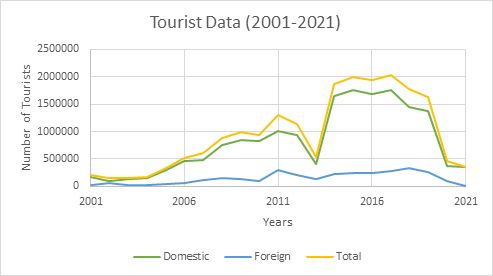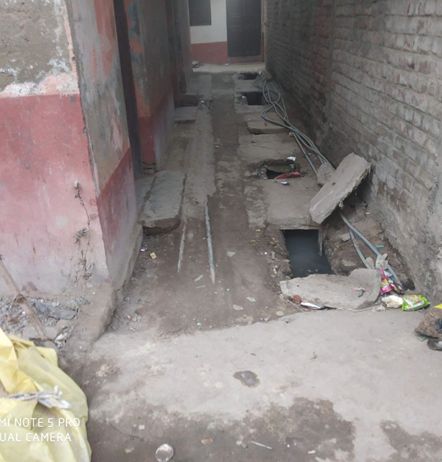
Bodh Gaya, a globally venerated small town, derives its significance as the birthplace of Buddhism. It is considered as the 'navel of the earth' (Pathavinabhi) among Buddhists. The recognition of the Mahabodhi Temple as a United Nations Educational, Scientific and Cultural Organisation (UNESCO) world heritage site has endorsed its prominence since 2002.
The Gaya International Airport also got operationalised in the same year, enabling international connectivity, especially in Southeast Asia. Hence, the massive tourists’ influx, and a booming tourism industry (hotels and guesthouses) have altered Bodh Gaya's landscape. The figure below depicts the increase in the number of tourists in the last two decades (2001–2021). The 2013 plunge was because of bomb blast and the impact of COVID-19 is also evident.

In terms of governance, Bodh Gaya was notified as Nagar Parishad in 2021, with a population of 72,000 and an area of 34 sq. km. Even though Bodh Gaya emerged as a major tourist destination, however, most of the local population remained dependent on agriculture and other rural-based activities to support their livelihood. The intersectionality of Bodh Gaya’s religious importance and agrarian roots has produced an interesting waterscape. Groundwater is the ultimate source of water for the town. Currently, water is provided to the households by a state agency (Public Health and Engineering Department (PHED)) and a public-private venture (Jindal Water Infrastructure Limited (JWIL)) (Figure below).

Bodh Gaya’s water distribution network
Bodh Gaya got its first network water supply when it was a “big village” during the Mahaparniravana celebration, which marked the 2500th birth anniversary of the Buddha in 1956. The pipeline was installed under the Rural Water-Supply and Sanitation Program of the Government of India, with an overall cost of INR 315,000. Two tube wells at the edge of the Niranjana River and one overhead tank of 50000-gallon capacity near the Mahabodhi Temple Complex were installed.
Bodh Gaya was selected under the Jawaharlal Nehru National Urban Renewal Mission (JNNURM) primarily due to its religious and cultural importance in 2006. A water supply scheme as public-private venture of INR 33.55 crores was installed under the mission to meet households’ drinking water demand. The project is under Bihar Urban Infrastructure Development Corporation (BUIDCO), which gave a tender to a private company, Jindal ITF Water Supply. However, the water supply network is spatially confined to the core of the town (the settlements around the Mahabodhi Temple).
Furthermore, the scheme failed to consider the needs and demands of tourists or pilgrims and institutions (such as hotels and monasteries) catering to the floating population in the town. Currently, nearly 150 monasteries and hotels are functioning in Bodh Gaya to cater to pilgrims and tourists, a significantly large number given the town's small size. These institutes mainly depend on groundwater to meet their water demands. On average, three to five borewells are installed at a depth of more than 100 feet in these institutions. The operation of borewells depends on the number of tourists and varies across the seasons.
Water and worries
At household level, this public-private venture has abysmally failed. In several wards, the pipelines laid by Jindal are left on the roads without taps (refer to figure 4). Many households reported that Jindal left the pipes at their door without a tap. The Density Polyethylene (DPE) pipes can be seen lying around in the all-around Bodh Gaya. One official from the Jindal Delhi office informed us that the pipelines should be made available at residents' doorstep by “contract”. Such interpretations pinpoint the failure in consideration of "the pragmatic interpretation" of the contract, which is one of the prerequisites for the success of a private operator in a city.

Moreover, around 55 per cent of the population of Bodh Gaya resides in slum-designated areas. In these slum-designated areas, no piped water supply is available within the house's premises. These households depend on the stand-post (if available nearby) or the community hand pumps, which get dried during the dry period. A ward member (18) of the BGNP emphasised that water is a major concern for the poor, especially those who do not have the financial capability to exploit resources as the hotel and monasteries have.
The water shortage is well-recognised in Bodh Gaya among the residents. Interestingly, none of the hotels and monasteries consider water scarcity or water stress a problem. Residents living in adjacent neighbourhoods narrate the story of water poverty and water stress in deep detail. Due to the seasonality of the pilgrimage, i.e., post-monsoon, and the depth of the borewells in which these institutes have excess, they do not face water crisis as such. Some hotels and monasteries reported that borewells dries up in May and June, i.e., pre-monsoon. These institutes do not require a large quantity of water because of the low tourist load during the off-season.
However, the residents, especially the poor, have to bear the brunt of the water stress. During the dry season (summer months), the hand pumps and borewells, which are 30-35 feet for most households, get dried up. The poor sections of the urban population getting limited benefits from the tourist sector are impacted the most. They are left to look for individual and communitarian coping strategies to deal with water stress in the summer.
In sum, Bodh Gaya’s water infrastructure is precarious, unavailable and inaccessible to most of its residents. Instead of relying on the ideals of centralised grid-based water supply networks to make water available for the whole populace, a more decentralised and hybrid service delivery institutions are needed to reach the diverse local population. The decentralised public water provisioning systems must be supported through appropriate regulatory measures and participatory planning initiatives to make it socially just and environmentally benign.
Author: Ritika Rajput is an independent researcher. The article is based on the recently published paper in Habitat International in March, 2023: Rajput, R., & Sharma, A. (2023). Water economies of Bodh Gaya, Bihar: Urban water in Rural Town. Habitat International, 133, 102754, can be accessed here: https://www.sciencedirect.com/science/article/abs/pii/S0197397523000140
/articles/water-and-worries-bodh-gaya